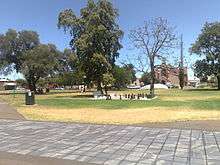Whitmore Square


Whitmore Square is a public square in the centre of the south-western quarter of the Adelaide city centre. It surrounds the intersection of Sturt and Morphett Streets. It was named by the Street Naming Committee after William Wolryche Whitmore, a British Member of Parliament who introduced the South Australia Foundation Act to the British House of Commons.[1] It is also known as Ivaritji, a Kaurna name meaning "gentle, misty rain." Ivaritji (1847?-1929), also known as Amelia Taylor, was the (then) last remaining speaker of the Kaurna language.[2]
History
Whitmore Square is one of six squares in Colonel William Light’s 1837 plan for the city of Adelaide and the only one which retains the configuration given to it by Light’s plan.[3] Light intended that the squares be used as public parks or village commons.[2]
After the removal of indigenous trees during the city’s early colonial settlement, Whitmore Square was replanted in the 1850s and fenced to protect it from animals. The fences were finally removed in 1932.[2] In the 1930s the square was a meeting place for people to discuss current affairs as well as a place for local children to play.[4] During World War II air raid trenches were installed in the square and it was used for training of soldiers. From 1909-1958 the northwest corner of the square was cut off by electric tram tracks.[2]
By the 1990s the square had become known as a place for down and outers, drink, drugs and prostitution. There were many homeless people in the park and it was seen as an unsafe place to be at night.[4] The square was made a dry zone in 2001, and a nearby strip club converted into live music venue Whitmore Hotel.[4] A giant chess board and a basketball half-court were installed in 2007 and 2009 respectively.[2] The square has again become a more “community-orientated park” with a Community Verge Garden on the western side.[4] Regular events are held in the square including food truck fairs and film nights.[4]
In December 2007, a public artwork, Voyagers, was unveiled on the western side of Whitmore Square. It commemorates the Afghan cameleers who lived nearby and worshipped at the Central Adelaide Mosque when not working in the outback.[5]
References
- ↑ "History of Adelaide Through Street Names". History of South Australia website. Retrieved 2008-07-25.
- 1 2 3 4 5 Clark, Amber; Ramm, Kara-Lee; McInnes, Simone; Elton, Jude. "Whitmore Square, SA History Hub". History SA. Retrieved 9 November 2014.
- ↑ "Adelaide Park Lands & Squares: Whitmore Square Report" (PDF). Adelaide City Council. Retrieved 9 November 2014.
- 1 2 3 4 5 Staff Writers (25 November 2013). "Whitmore: Renaissance of our neglected Adelaide CBD square". City Messenger. Retrieved 9 November 2014.
- ↑ Elton, Jude (2013). "Voyagers". History SA. Retrieved 9 November 2014.
Coordinates: 34°55′58″S 138°35′39″E / 34.9328°S 138.5942°E
| |||||||||||||||||||||||
| ||||||||||||||||||||||||||||||||||||||||||||||||||||